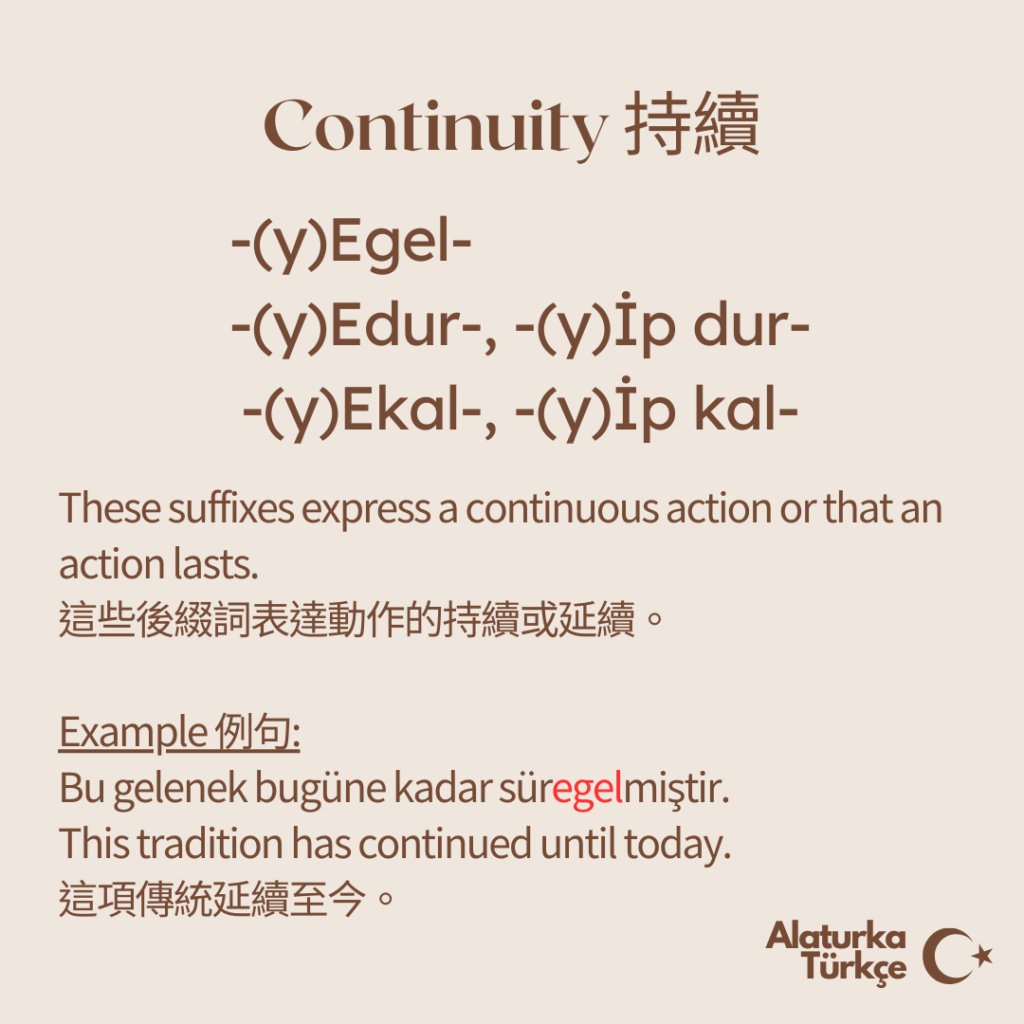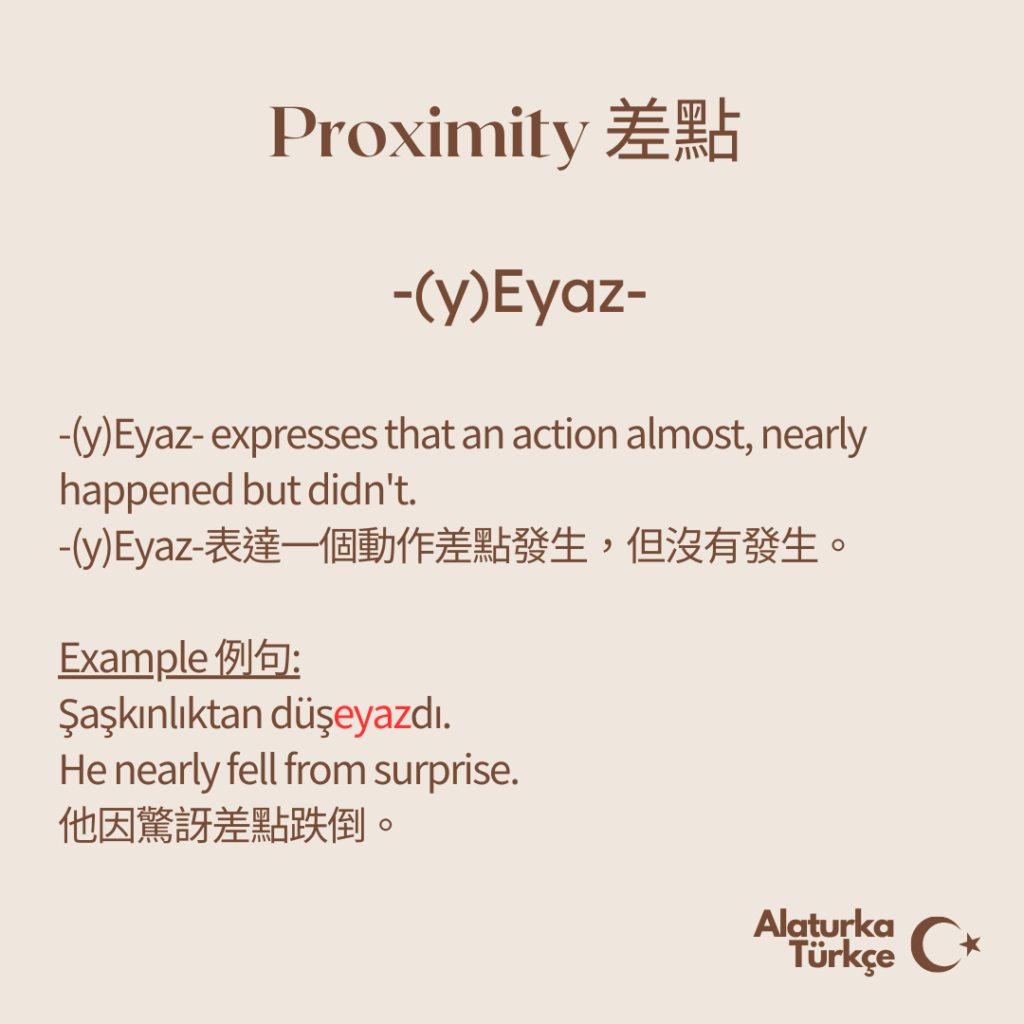[This article is written in both English and Chinese. Scroll down to read in either language. 本篇文章有英文和中文版本,可下滑看任一語言版本。]
We can express swiftness, continuity and proximity of an action — the grammatical aspect — by adding a suffix to the verb stem. This is part of the regular compound verbs called “kurallı birleşik fiiller” in Turkish. For what the suffix markings mean, please see the usage guide.
Swiftness (Tezlik): -(y)İver-

To express swiftness or suddenness of an action, or the each with which an action is performed, we add -(y)İver- to the verb stem.
e.g. Kahvaltı yaptıktan sonra okula gidiverdi. (After having breakfast, he/she quickly went to school.)
Continuity (sürerlik/sürerlilik/süreklik/süreklilik): -(y)Egel-; -(y)Edur-, -(y)İp dur-; -(y)Ekal-, -(y)İp kal-

To express a continuous action or that an action has lasted for a while, for example when it is habitual or customary, we can use these three sets of suffixes for slightly different purposes.
- -(y)Egel- indicates that an action is habitual or customary, such as when it has lasted for a while or has been this way for a while.
e.g. Bu gelenek bugüne kadar süregelmiştir. (This tradition has continued until today.)

- -(y)Edur- indicates a continuous action and is mostly used in the imperative form.
e.g. Sen gidedur, ben sana yetişirim. (You keep going, I’ll catch up with you.)
Its other form is -(y)İp dur-, which is more common and is not limited to the imperative form.
e.g. Yan masada oturanlar bize bakıp duruyor. (The people sitting at the next table keep looking at us.)
- -(y)Ekal- also indicates a continuous action and oftentimes expresses a transition from one state to another, such as when someone is left stunned. It also has the form -(y)İp kal-, which is also more common.
e.g. O giderken arabanın ardından bakakaldık. (As he/she drove away, we stared after the car.)
Haberi duyunca hepimiz donup kaldık. (When we heard the news, we all froze/were stunned.)
Proximity (yaklaşma): -(y)Eyaz-

To express that an action almost, nearly happened but didn’t, we add -(y)Eyaz- to the verb stem.
e.g. Şaşkınlıktan düşeyazdı. (He nearly fell from surprise.)
[中文]
當我們想表達一個動作的快速性、持續性,或一個動作差點發生,可以藉由在動詞字根加上後綴詞來達到這個目的,即是文法中的體貌(詞)。這些後綴動詞是規則複合動詞中的一部分,在土耳其語稱作「kurallı birleşik fiiller」。有關文法標示所代表的意思,可以參見用法說明。
用來表達快速(tezlik)的後綴詞:-(y)İver-

表達一個動作的快速或突然,或者是動作輕易、簡單地完成,我們將-(y)İver-加在動詞字根後面。
例句:Kahvaltı yaptıktan sonra okula gidiverdi. (吃完早餐後,他很快地去學校。)
用來表達動作持續(sürerlik/sürerlilik/süreklik/süreklilik)的後綴詞:-(y)Egel-; -(y)Edur-, -(y)İp dur-; -(y)Ekal-, -(y)İp kal-

表達一個動作持續著或延續了一段時間,例如該動作是經常性或慣常地發生,有三組後綴詞用在些微不同的情境上。
- -(y)Egel-表示一個動作是經常性、慣常地發生,像是一件事已維持些許時間了,或一段時間一直是如此。
例句:Bu gelenek bugüne kadar süregelmiştir. (這項傳統延續至今。)

- -(y)Edur-表示一個持續的動作,並且大部分都用於祈使語句。
例句:Sen gidedur, ben sana yetişirim. (你繼續走,我會追上你的。)
它有另一型態是-(y)İp dur-,這種型態較常用,而且不侷限於用在祈使語句上。
例句:Yan masada oturanlar bize bakıp duruyor. (隔壁桌的人一直在看我們。)
- -(y)Ekal-也表示一個持續的動作,並且常用來表達情緒狀態的轉換,例如因一件事情受到震驚。 它也有另一種型態-(y)İp kal-,這個型態也是較常使用的。
例句:O giderken arabanın ardından bakakaldık. (他開車離開時,我們在後凝望著。)
Haberi duyunca hepimiz donup kaldık. (當我們聽到消息時,全都驚呆了。)
用來表達一個動作差點(yaklaşma)發生的後綴詞:-(y)Eyaz-

表達一個動作差點發生,但沒有發生,我們將-(y)Eyaz-加到動詞字根後面。
例句:Şaşkınlıktan düşeyazdı. (他因驚訝差點跌倒。)

